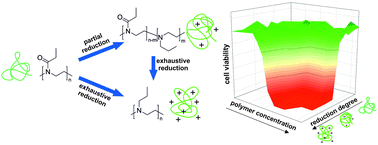Poly(2-ethyl-2-oxazoline-co-N-propylethylene imine)s by controlled partial reduction of poly(2-ethyl-2-oxazoline): synthesis, characterization and cytotoxicity†
Abstract
The partial reduction of poly(2-ethyl-2-oxazoline) was investigated. A series of poly(2-ethyl-2-oxazoline-co-N-propylethylene imine)s were synthesized by direct reduction using lithium aluminum hydride or borane/dimethylsulfide (BH3/DMS), respectively. It is shown that the degree of reduction can be readily controlled either by the reaction time when using an excess of LiAlH4 or by the stoichiometry of BH3/DMS, as was demonstrated by 1H-NMR spectroscopy. Differential scanning calorimetry revealed that the glass transition temperature of the products decreased with increasing degree of reduction up to 25% of reduction, above which no glass transition could be detected. Moreover, acid–base titration showed a very pronounced, reduction degree dependent buffering capacity of these polymers between pH 4 and 8, which is of great interest, e.g. in the context of endosomal escape. This control over the reduction allows to tailor the synthesis of partially cationic polymers on the basis of poly(2-oxazoline)s, which, in combination over the hydrophilic/lipophilic balance through the side chain length allows a tight control over materials properties. Such materials may be interesting, inter alia, for biomaterials or organic electronics.



 Please wait while we load your content...
Please wait while we load your content...